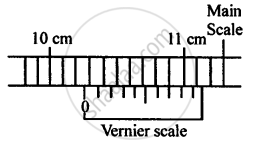Advertisements
Advertisements
प्रश्न
A boy uses a vernier callipers to measure the thickness of his pencil. He measures it to be 1.4 mm. If the zero error of vernier callipers is +0.02 cm, what is the correct thickness of the pencil?
उत्तर
Thickness of the pencil (observed reading) = 1.4 mm
Zero error = + 0.02 cm = + 0.2 mm
Correct reading = observed reading - zero error (with sign)
= 1.4 mm - 0.2 mm
= 1.2 mm
APPEARS IN
संबंधित प्रश्न
A vernier callipers has a zero error of + 0.06 cm. Draw a neat labelled diagram to represent it.
When a screw gauge with a least count of 0.01 mm is used to measure the diameter of a wire, the reading on the sleeve is found to be 1 mm and the reading on the thimble is found to be 27 divisions.
(i) What is the diameter of the wire in cm?
(ii) If the zero error is +0.005 cm, what is the correct diameter?
Fig., below shows the reading obtained while measuring the diameter of a wire with a screw gauge. The screw advances by 1 division on the main scale when circular head is rotated once.
 Find:
Find:
(i) Pitch of the screw gauge,
(ii) Least count of the screw gauge and
(iii) The diameter of the wire.
The final result of the calculation in an experiment is 125,347,200. Express the number in term of significant place when accuracy is between 1 and 1000
Figure shows the position of vernier scale while measuring the external length of a wooden cylinder.
- What is the length recorded by the main scale?

- Which reading of vernier scale coincides with the main scale?
- Calculate the length.
The least count of a vernier callipers is 0.01 cm and it has an error of + 0.07 cm. While measuring the radius of a sphere, the main scale reading is 2.90 cm and the 5th vernier scale division coincides with the main scale. Calculate the correct radius.
What do you understand by the term least count of screw?
What is the least count in the case of the following instrument?
Thermometer
